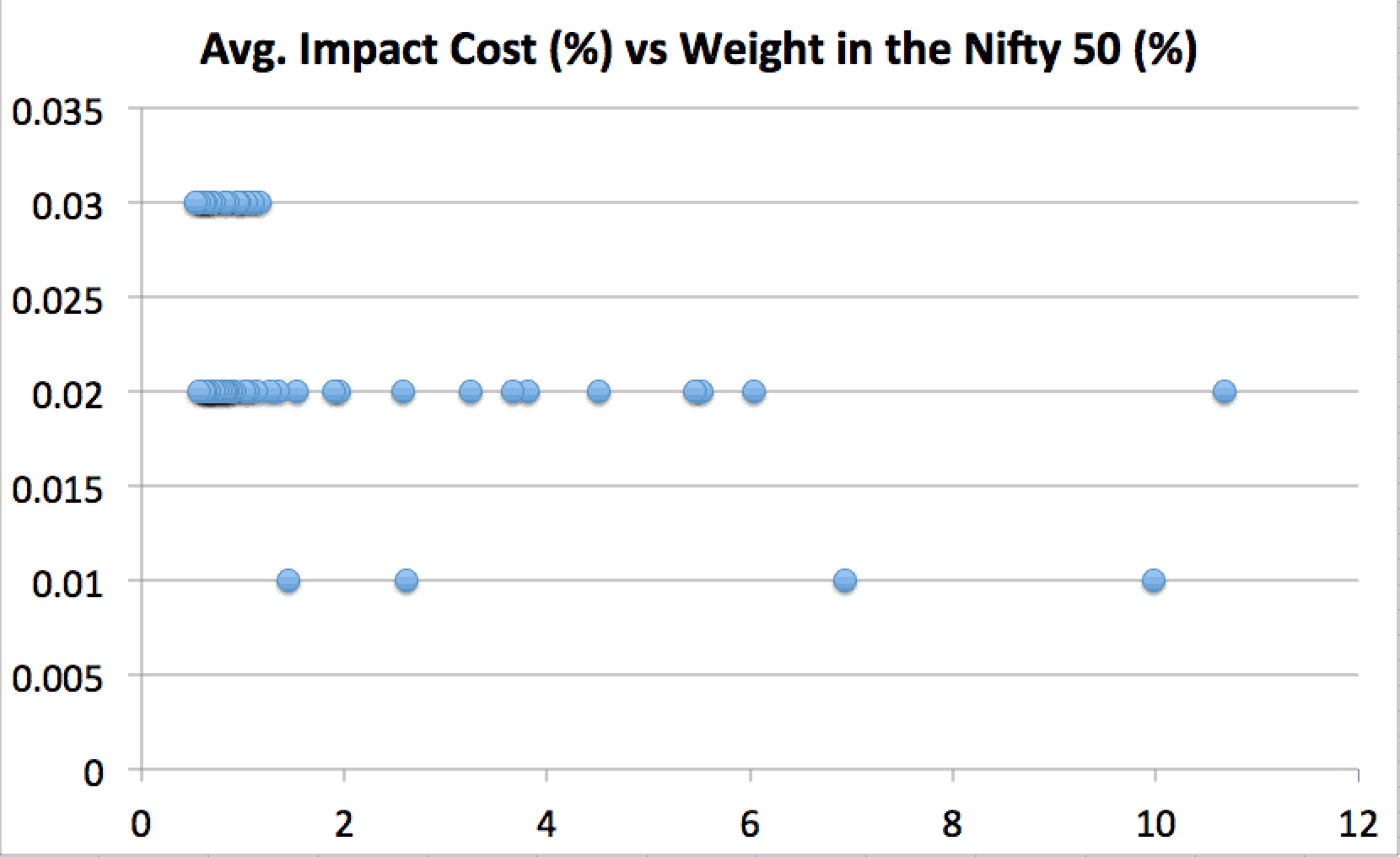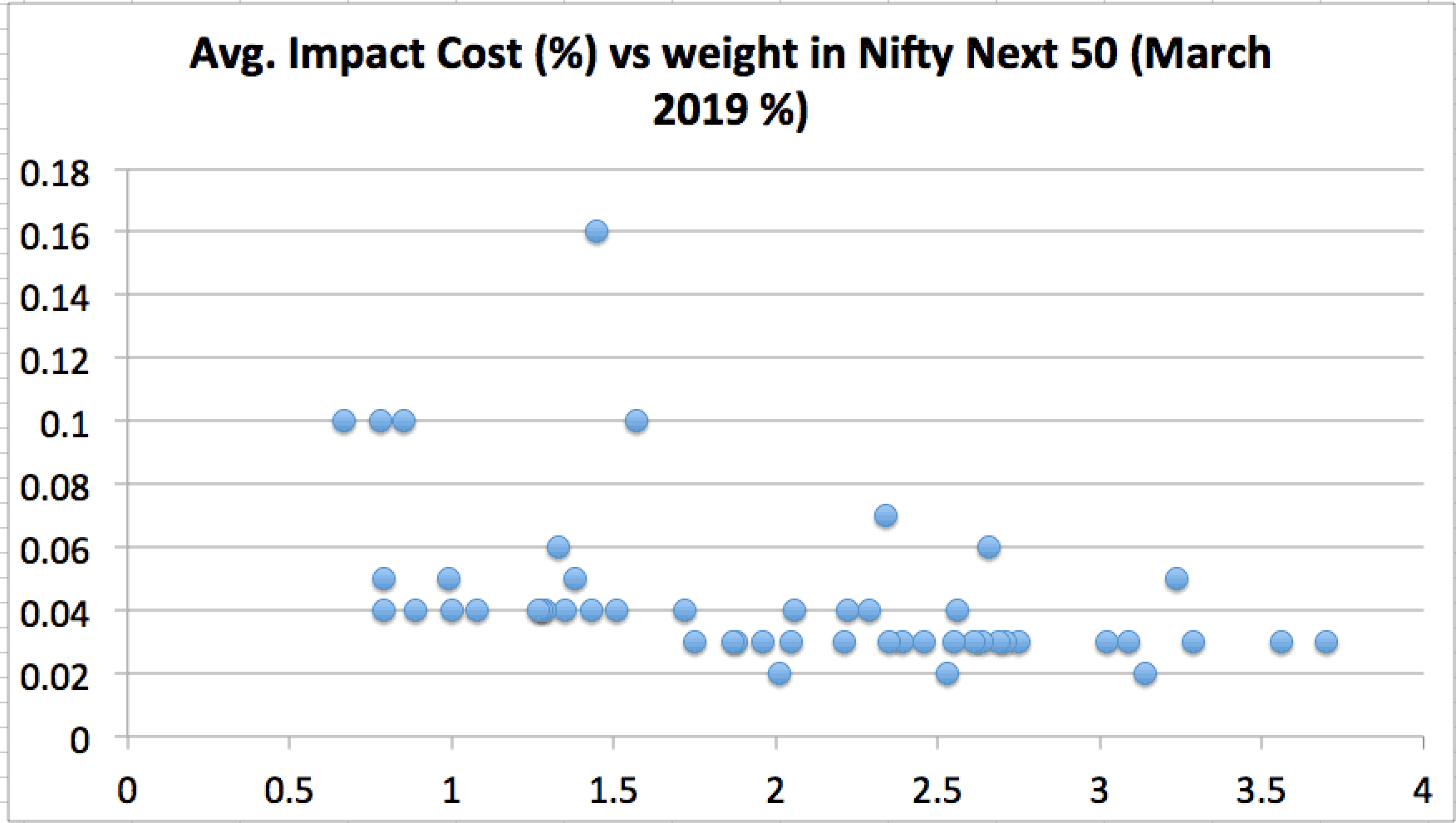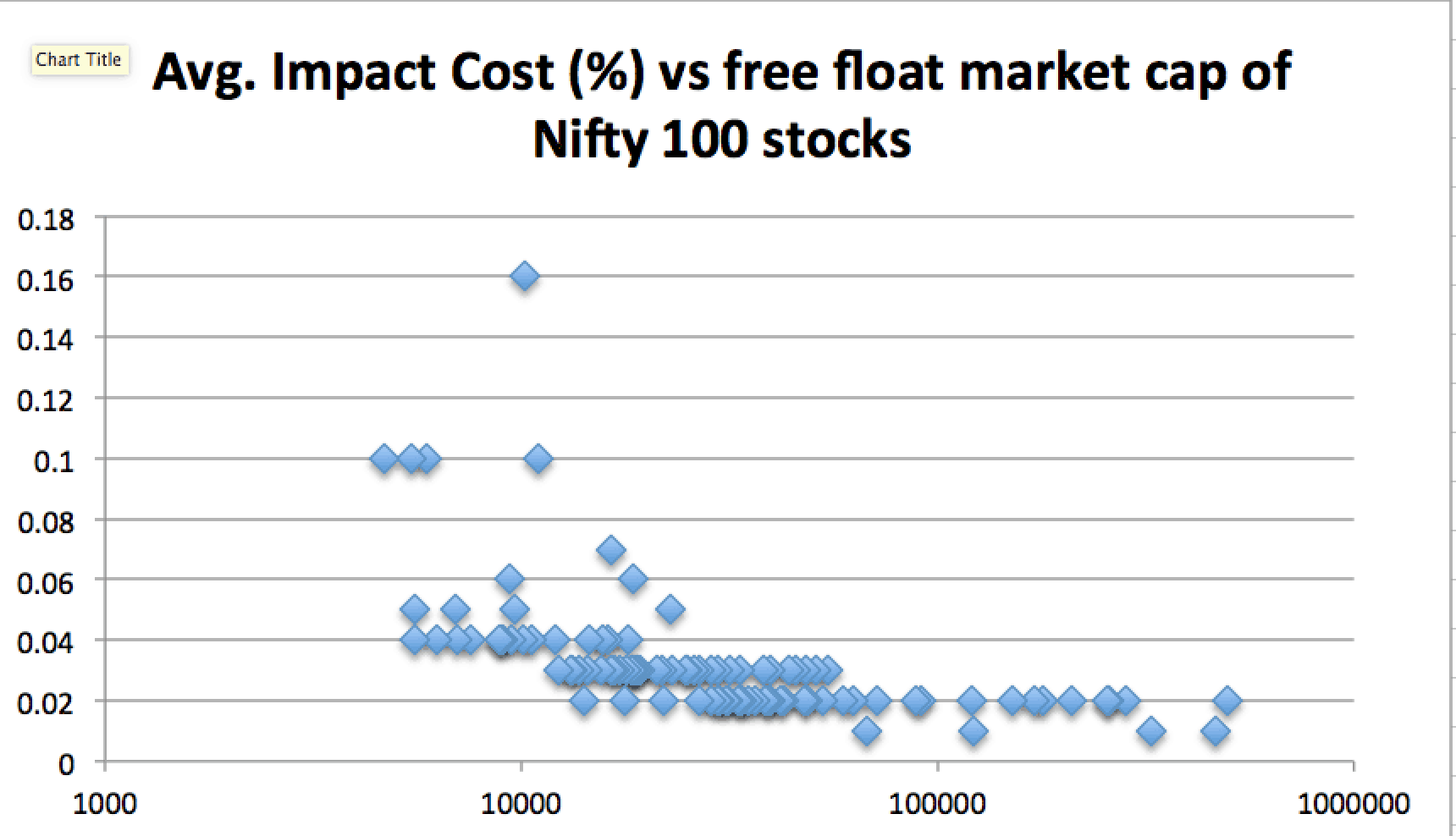Last Updated on December 29, 2021 at 12:58 pm
Stock investors would be well aware of a small difference between the buy-price and sell-price of a share, known as the bid-ask spread. This “cost” or “loss” (applicable for an immediate buy and sell) is inevitable and quite different from brokerage costs. The price difference is a measure of liquidity in the market. The bid-ask spread applies only for small quantities of stocks purchased or sold. Institutional investors (including mutual fund managers) face different liquidity constraints. We discuss why even the so-called large cap stocks are not liquid enough and pose difficulties for mutual fund managers.
When one needs to buy/sell huge quantities of a share, it will have to be done in lots as determined by the stock exchange “order book”. Since the bid-ask spread applies to only the first lot of shares, large transactions use a different measure of liquidity known as impact cost. This is best explained via an example.
What is impact cost?
The following example has been derived from the NSEs impact cost definition page. Suppose the stock exchange order book at some instant of time look like this
| Quantity | Buy Price | Sell Price |
| 1000 | 100 | 102 |
| 2000 | 99 | 103 |
| 1500 | 96 | 104 |
The quantity of shares for buying and selling will be different but we have assumed it to be the same to keep things simple. Suppose I want to buy 2000 shares, ideally, I should be able to all of them at the selling price of Rs. 102. Since the buying price is Rs. 100 the bid-ask spread is only Rs 2. So we first define the ideal buying price as (102+100)/2 = 101
Join 32,000+ readers and get free money management solutions delivered to your inbox! Subscribe to get posts via email! (Link takes you to our email sign-up form)
🔥Want to create a complete financial plan? Learn goal-based investing? Exclusive access to our DIY tools? Increase your income with your skills? Use this link to enjoy massive discounts on our robo-advisory tool & courses! 🔥
However, I can only buy 1000 shares in one lot at Rs. 102. The second lot of 1000 shares will be purchased at Rs. 103 (assume instant buys). So the average buying price for this trade is:
[(1000 x102) + (1000 x 103)]/2000 = 102.5
This Rs. 102.5 is 1.5% higher than the ideal buying price of Rs. 101. This 1.5% is known as the impact cost (for buying).
Impact cost is dynamic and depends on the quantity of shares involved in the transaction. There is a separate impact cost of buying and selling. The exchange can impost a penalty in case the stock is not liquid enough resulting in a higher cost.
Impact cost of Nifty 50 stocks (March 2019)
The NSE publishes impact cost for Nifty 50 and Nifty Next 50 each month. For a stock to be eligible for inclusion in the Nifty 50, its impact cost should be 0.5% or less for 90% of its transactions. The Nifty has a weighted average impact cost for a portfolio of Rs. 50 Lakh = 0.02%
| Security Name | Weightage (%) | Avg. Impact Cost (%) |
| HDFC Bank Ltd. | 10.67 | 0.02 |
| Reliance Industries Ltd. | 9.98 | 0.01 |
| Housing Development Finance Corporation Ltd. | 6.94 | 0.01 |
| Infosys Ltd. | 6.04 | 0.02 |
| ICICI Bank Ltd. | 5.52 | 0.02 |
| I T C Ltd. | 5.45 | 0.02 |
| Tata Consultancy Services Ltd. | 4.5 | 0.02 |
| Kotak Mahindra Bank Ltd. | 3.81 | 0.02 |
| Larsen & Toubro Ltd. | 3.66 | 0.02 |
| Axis Bank Ltd. | 3.25 | 0.02 |
| Hindustan Unilever Ltd. | 2.61 | 0.01 |
| State Bank of India | 2.57 | 0.02 |
| IndusInd Bank Ltd. | 1.95 | 0.02 |
| Maruti Suzuki India Ltd. | 1.9 | 0.02 |
| Bajaj Finance Ltd. | 1.53 | 0.02 |
| Asian Paints Ltd. | 1.44 | 0.01 |
| Mahindra & Mahindra Ltd. | 1.34 | 0.02 |
| HCL Technologies Ltd. | 1.26 | 0.02 |
| NTPC Ltd. | 1.17 | 0.03 |
| Sun Pharmaceutical Industries Ltd. | 1.13 | 0.02 |
| Yes Bank Ltd. | 1.09 | 0.03 |
| Tech Mahindra Ltd. | 1.04 | 0.02 |
| Oil & Natural Gas Corporation Ltd. | 1.03 | 0.03 |
| Titan Company Ltd. | 1.02 | 0.02 |
| Power Grid Corporation of India Ltd. | 0.97 | 0.03 |
| Bharti Airtel Ltd. | 0.94 | 0.03 |
| Bajaj Finserv Ltd. | 0.91 | 0.02 |
| UltraTech Cement Ltd. | 0.89 | 0.02 |
| Bajaj Auto Ltd. | 0.85 | 0.02 |
| Coal India Ltd. | 0.85 | 0.03 |
| Tata Steel Ltd. | 0.84 | 0.02 |
| Indian Oil Corporation Ltd. | 0.82 | 0.03 |
| Wipro Ltd. | 0.82 | 0.02 |
| Britannia Industries Ltd. | 0.78 | 0.02 |
| UPL Ltd. | 0.75 | 0.02 |
| Dr. Reddy’s Laboratories Ltd. | 0.72 | 0.02 |
| Grasim Industries Ltd. | 0.72 | 0.02 |
| Vedanta Ltd. | 0.72 | 0.03 |
| Hero MotoCorp Ltd. | 0.71 | 0.02 |
| Tata Motors Ltd. | 0.68 | 0.03 |
| GAIL (India) Ltd. | 0.67 | 0.02 |
| Bharat Petroleum Corporation Ltd. | 0.66 | 0.02 |
| Adani Ports and Special Economic Zone Ltd. | 0.64 | 0.03 |
| Hindalco Industries Ltd. | 0.64 | 0.02 |
| JSW Steel Ltd. | 0.64 | 0.02 |
| Eicher Motors Ltd. | 0.61 | 0.02 |
| Indiabulls Housing Finance Ltd. | 0.61 | 0.03 |
| Bharti Infratel Ltd. | 0.57 | 0.03 |
| Cipla Ltd. | 0.57 | 0.02 |
| Zee Entertainment Enterprises Ltd. | 0.53 | 0.03 |
No stock in the Nifty 50 (at the time of writing) has an impact cost two standard deviations above the average (not weighted). However, no stock has an impact cost lower than two standard deviations from the average. This means that no stock in the NIfty has exceptional liquidity. Amusingly the stock with the highest weight in the Nifty, HDFC Bank has twice the impact cost of Reliance Industries Ltd. (second highest in weight).
While one can approximately say, lower the weight in the Nifty, higher the impact cost, higher the loss when large quantities are transacted and lower the liquidity, it is not rigorously true.
Please take a moment to recognise the dificulty of Nfity 50 Equal weight index fund manager vs a Nifty 50 Index fund manager. The former will have a tough time tracking the index as the AUM increases.
Impact cost of Nifty Next 50 stocks (March 2019)
The NIfty Next 50 has a weighted average impact cost of 0.04% for a portfolio of Rs. 25 Lakh. This is 2X the impact cost of Nifty 50 for 0.5X the portfolio size!! Again proof of the earlier warning issued: Nifty Next 50 is NOT a large cap index!
| Security Name | Weightage (%) | Avg. Impact Cost (%) |
| Godrej Consumer Products Ltd. | 3.7 | 0.03 |
| Piramal Enterprises Ltd. | 3.56 | 0.03 |
| Dabur India Ltd. | 3.29 | 0.03 |
| Shree Cement Ltd. | 3.24 | 0.05 |
| Aurobindo Pharma Ltd. | 3.14 | 0.02 |
| Divi’s Laboratories Ltd. | 3.09 | 0.03 |
| Hindustan Petroleum Corporation Ltd. | 3.02 | 0.03 |
| Havells India Ltd. | 2.75 | 0.03 |
| Pidilite Industries Ltd. | 2.71 | 0.03 |
| Petronet LNG Ltd. | 2.69 | 0.03 |
| Bajaj Holdings & Investment Ltd. | 2.66 | 0.06 |
| Shriram Transport Finance Co. Ltd. | 2.64 | 0.03 |
| HDFC Life Insurance Company Ltd. | 2.61 | 0.03 |
| Motherson Sumi Systems Ltd. | 2.56 | 0.04 |
| Marico Ltd. | 2.55 | 0.03 |
| Lupin Ltd. | 2.53 | 0.02 |
| Ambuja Cements Ltd. | 2.46 | 0.03 |
| Colgate Palmolive (India) Ltd. | 2.39 | 0.03 |
| United Spirits Ltd. | 2.35 | 0.03 |
| ICICI Lombard General Insurance Company Ltd. | 2.34 | 0.07 |
| Bosch Ltd. | 2.29 | 0.04 |
| Avenue Supermarts Ltd. | 2.22 | 0.04 |
| United Breweries Ltd. | 2.21 | 0.03 |
| Page Industries Ltd. | 2.06 | 0.04 |
| Container Corporation of India Ltd. | 2.05 | 0.03 |
| ACC Ltd. | 2.01 | 0.02 |
| InterGlobe Aviation Ltd. | 1.96 | 0.03 |
| Biocon Ltd. | 1.88 | 0.03 |
| Ashok Leyland Ltd. | 1.87 | 0.03 |
| Bank of Baroda | 1.75 | 0.03 |
| MRF Ltd. | 1.72 | 0.04 |
| Vodafone Idea Ltd. | 1.57 | 0.1 |
| ICICI Prudential Life Insurance Company Ltd. | 1.51 | 0.04 |
| Procter & Gamble Hygiene & Health Care Ltd. | 1.45 | 0.16 |
| Siemens Ltd. | 1.43 | 0.04 |
| Bharat Heavy Electricals Ltd. | 1.38 | 0.05 |
| L&T Finance Holdings Ltd. | 1.35 | 0.04 |
| SBI Life Insurance Company Ltd. | 1.33 | 0.06 |
| DLF Ltd. | 1.29 | 0.04 |
| NMDC Ltd. | 1.28 | 0.04 |
| Cadila Healthcare Ltd. | 1.27 | 0.04 |
| Oracle Financial Services Software Ltd. | 1.08 | 0.04 |
| Hindustan Zinc Ltd. | 1 | 0.04 |
| ABB India Ltd. | 0.99 | 0.05 |
| Bandhan Bank Ltd. | 0.89 | 0.04 |
| General Insurance Corporation of India | 0.85 | 0.1 |
| Steel Authority of India Ltd. | 0.79 | 0.05 |
| HDFC Asset Management Company Ltd. | 0.79 | 0.04 |
| NHPC Ltd. | 0.78 | 0.1 |
| The New India Assurance Company Ltd. | 0.67 | 0.1 |
Most of the Nifty Next 50 stocks have an impact cost at least twice that of Nifty 50.
Most illiquid “large cap” stocks (March 2019)
If you combine Nifty and Nifty Next 50 these these stocks have an impact cost greater than two standard deviations above the (unweighted) impact cost!!
| Security Name | Weightage (in Nifty next 50) (%) | Avg. Impact Cost (%) |
| Procter & Gamble Hygiene & Health Care Ltd. | 1.45 | 0.16 |
| Vodafone Idea Ltd. | 1.57 | 0.1 |
| General Insurance Corporation of India | 0.85 | 0.1 |
| NHPC Ltd. | 0.78 | 0.1 |
| The New India Assurance Company Ltd. | 0.67 | 0.1 |
Now imgaine the plight of the two Nifty 100 Equal Weight Index fund manages (from Principal and Sundaram). They would have a pretty tough time tracking the Index. The same could be true of the Nifty LargeMidcap 250 Index (IF and when it is announced by Motilal Oswal)
Impact cost vs Free float market cap of NIfty 100 stocks
If we combine the above data, it can be seen that there is a step wise increase in impact cost as the free float market cap decreases.
If we define impact costs of 0.04 and above as “expensive” then at least 25% of the “large cap universe” as defined by SEBI has significantly lower liquidity than top 75% (in terms of free float market cap).
What does this mean? How does it affect me?
Imagine if there is a huge sell-off resulting in plunging prices. This lack of liquidity will result in big losses for a Nifty Next 50 Index (or ETF) investor. The same is true of midcap and small cap mutual funds too. If you want to invest in more of these, then be prepared for huge volatility. Most people who talk about having a “high-risk appetite” have never seen big market falls. I have already shown how Nifty Next 50 is a lot more volatile than Nifty: Warning! Nifty Next 50 is NOT a large cap index! This article ties up to the risk to the relative lack of liquidity.

Use our Robo-advisory Tool to create a complete financial plan! ⇐More than 3,000 investors and advisors use this! Use the discount code: robo25 for a 20% discount. Plan your retirement (early, normal, before, and after), as well as non-recurring financial goals (such as child education) and recurring financial goals (like holidays and appliance purchases). The tool would help anyone aged 18 to 80 plan for their retirement, as well as six other non-recurring financial goals and four recurring financial goals, with a detailed cash flow summary.
🔥You can also avail massive discounts on our courses and the freefincal investor circle! 🔥& join our community of 8000+ users!
Track your mutual funds and stock investments with this Google Sheet!
We also publish monthly equity mutual funds, debt and hybrid mutual funds, index funds, and ETF screeners, as well as momentum and low-volatility stock screeners.
You can follow our articles on Google News

We have over 1,000 videos on YouTube!

Join our WhatsApp Channel



- Do you have a comment about the above article? Reach out to us on Twitter: @freefincal or @pattufreefincal
- Have a question? Subscribe to our newsletter using the form below.
- Hit 'reply' to any email from us! We do not offer personalised investment advice. We can write a detailed article without mentioning your name if you have a generic question.
Join 32,000+ readers and get free money management solutions delivered to your inbox! Subscribe to get posts via email! (Link takes you to our email sign-up form)
About The Author
 Dr M. Pattabiraman (PhD) is the founder, managing editor and primary author of freefincal. He is an associate professor at the Indian Institute of Technology, Madras. He has over 13 years of experience publishing news analysis, research and financial product development. Connect with him via Twitter(X), LinkedIn, or YouTube. Pattabiraman has co-authored three print books: (1) You can be rich too with goal-based investing (CNBC TV18) for DIY investors. (2) Gamechanger for young earners. (3) Chinchu Gets a Superpower! for kids. He has also written seven other free e-books on various money management topics. He is a patron and co-founder of “Fee-only India,” an organisation promoting unbiased, commission-free, AUM-independent investment advice.
Dr M. Pattabiraman (PhD) is the founder, managing editor and primary author of freefincal. He is an associate professor at the Indian Institute of Technology, Madras. He has over 13 years of experience publishing news analysis, research and financial product development. Connect with him via Twitter(X), LinkedIn, or YouTube. Pattabiraman has co-authored three print books: (1) You can be rich too with goal-based investing (CNBC TV18) for DIY investors. (2) Gamechanger for young earners. (3) Chinchu Gets a Superpower! for kids. He has also written seven other free e-books on various money management topics. He is a patron and co-founder of “Fee-only India,” an organisation promoting unbiased, commission-free, AUM-independent investment advice.Our flagship course! Learn to manage your portfolio like a pro to achieve your goals regardless of market conditions! ⇐ More than 3,500 investors and advisors are part of our exclusive community! Get clarity on how to plan for your goals and achieve the necessary corpus no matter the market condition!! Watch the first lecture for free! One-time payment! No recurring fees! Life-long access to videos! Reduce fear, uncertainty and doubt while investing! Learn how to plan for your goals before and after retirement with confidence.
Increase your income by getting people to pay for your skills! ⇐ More than 800 salaried employees, entrepreneurs and financial advisors are part of our exclusive community! Learn how to get people to pay for your skills! Whether you are a professional or small business owner seeking more clients through online visibility, or a salaried individual looking for a side income or passive income, we will show you how to achieve this by showcasing your skills and building a community that trusts and pays you. (watch 1st lecture for free). One-time payment! No recurring fees! Life-long access to videos!
Our book for kids: “Chinchu Gets a Superpower!” is now available!


Must-read book even for adults! This is something that every parent should teach their kids right from their young age. The importance of money management and decision making based on their wants and needs. Very nicely written in simple terms. - Arun.Buy the book: Chinchu gets a superpower for your child!
How to profit from content writing: Our new ebook is for those interested in getting a side income via content writing. It is available at a 50% discount for Rs. 500 only!
Do you want to check if the market is overvalued or undervalued? Use our market valuation tool (it will work with any index!), or get the Tactical Buy/Sell timing tool!
We publish monthly mutual fund screeners and momentum, low-volatility stock screeners.
About freefincal & its content policy. Freefincal is a News Media organisation dedicated to providing original analysis, reports, reviews and insights on mutual funds, stocks, investing, retirement and personal finance developments. We do so without conflict of interest and bias. Follow us on Google News. Freefincal serves more than three million readers a year (5 million page views) with articles based only on factual information and detailed analysis by its authors. All statements made will be verified with credible and knowledgeable sources before publication. Freefincal does not publish paid articles, promotions, PR, satire or opinions without data. All opinions will be inferences backed by verifiable, reproducible evidence/data. Contact Information: To get in touch, please use our contact form. (Sponsored posts or paid collaborations will not be entertained.)
Connect with us on social media
- Twitter @freefincal
- Subscribe to our YouTube Videos
- Posts feed via Feedburner.
Our publications
You Can Be Rich Too with Goal-Based Investing
 Published by CNBC TV18, this book is designed to help you ask the right questions and find the correct answers. Additionally, it comes with nine online calculators, allowing you to create custom solutions tailored to your lifestyle. Get it now.
Published by CNBC TV18, this book is designed to help you ask the right questions and find the correct answers. Additionally, it comes with nine online calculators, allowing you to create custom solutions tailored to your lifestyle. Get it now.Gamechanger: Forget Startups, Join Corporate & Still Live the Rich Life You Want
 This book is designed for young earners to get their basics right from the start! It will also help you travel to exotic places at a low cost! Get it or gift it to a young earner.
This book is designed for young earners to get their basics right from the start! It will also help you travel to exotic places at a low cost! Get it or gift it to a young earner.Your Ultimate Guide to Travel
 This is an in-depth exploration of vacation planning, including finding affordable flights, budget accommodations, and practical travel tips. It also examines the benefits of travelling slowly, both financially and psychologically, with links to relevant web pages and guidance at every step. Get the PDF for Rs 300 (instant download)
This is an in-depth exploration of vacation planning, including finding affordable flights, budget accommodations, and practical travel tips. It also examines the benefits of travelling slowly, both financially and psychologically, with links to relevant web pages and guidance at every step. Get the PDF for Rs 300 (instant download)


